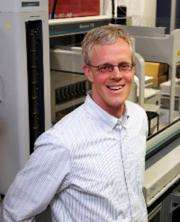'Surprising link' leads toward a new antibiotic

(PhysOrg.com) -- As the best drugs become increasingly resistant to superbugs, McMaster University researchers have discovered a completely different way of looking for a new antibiotic.
In a paper to be published published Friday, May 29 in the journal Chemistry and Biology, with colleagues in Germany and Wilfrid Laurier University, they report on work with the bacteria Staphylococcus aureus bacteria, the leading cause of infections in hospitals and the second most common community-acquired infection. Fewer and fewer antibiotics are effective against this bacteria.
Cell wall-active antibiotics, such as penicillin, kill bacteria by blocking production of the cell wall.
The researchers provide new evidence for genetic connections among three processes in the cell wall - teichoic acid, peptidoglycan and poly-isoprenoid synthesis. "Never before has such a profound link been drawn between these biosynthetic pathways supported by genetic, computational and biochemical evidence," they said in their paper.
"We found a connection that perhaps no one expected in the way the cell wall synthesis is wired," said lead author Eric Brown, professor and chair of the department of biochemistry and biomedical sciences in the Michael G. DeGroote School of Medicine.
"We found they are inextricably linked in their genetics and biochemistry," he said. "Along the way in this study, we have built a system that is ripe for being exploited as a way to search for small molecule drugs that would target these processes."
Potentially, he said, this may lead to the development of a new antibiotic.
Brown said the current arsenal of antibiotics was developed during the golden age of antibiotic drug discovery from 1930 to 1960, and then development stopped.
Research began again in earnest, he said, when troublesome strains of hospital and community-acquired infections began to emerge, such as MRSA (methicillin-resistant Staphylococcus aureus). "Since the 1960s, drug companies have for, the most part, been tweaking existing molecules, such as building better penicillin with minor changes to the original scaffold. But, you are not very far away from resistance when all you do is a little tweak."
The discovery of a "surprising link" between the three processes involved in cell wall synthesis lets researchers build a method of looking for molecules that will disturb the balance between them. "It offers a completely different way of looking for a new antibiotic that would be active against the cell wall," Brown said.
Source: McMaster University (news : web)

















